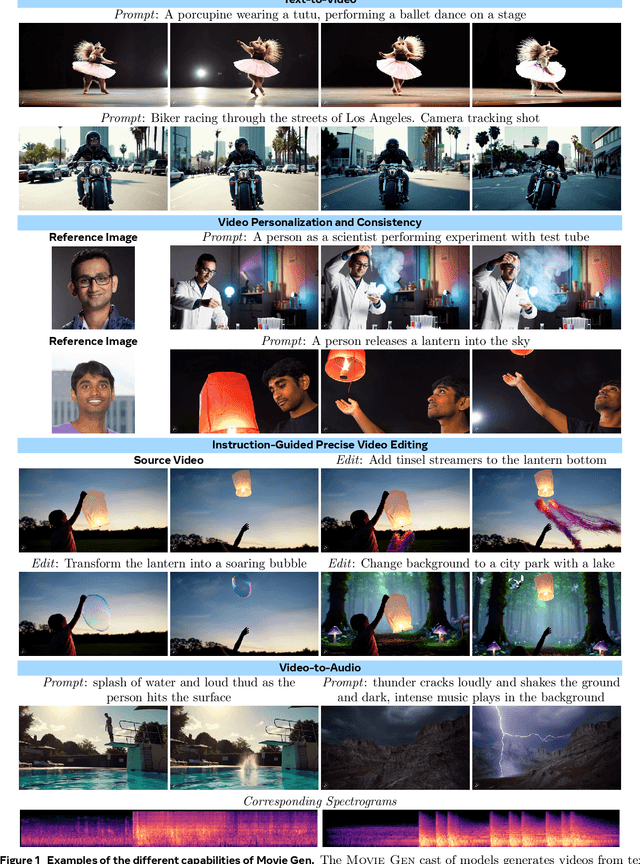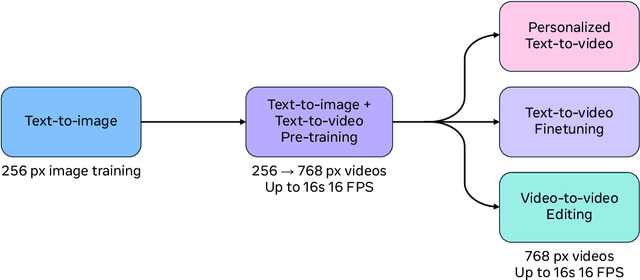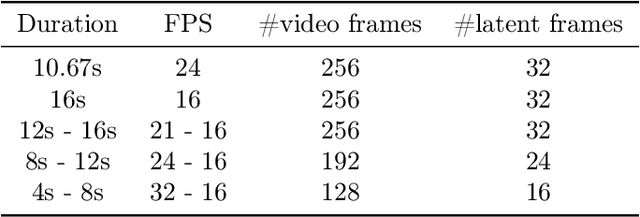Yaqiao Luo
DirectorLLM for Human-Centric Video Generation
Dec 19, 2024



Abstract:In this paper, we introduce DirectorLLM, a novel video generation model that employs a large language model (LLM) to orchestrate human poses within videos. As foundational text-to-video models rapidly evolve, the demand for high-quality human motion and interaction grows. To address this need and enhance the authenticity of human motions, we extend the LLM from a text generator to a video director and human motion simulator. Utilizing open-source resources from Llama 3, we train the DirectorLLM to generate detailed instructional signals, such as human poses, to guide video generation. This approach offloads the simulation of human motion from the video generator to the LLM, effectively creating informative outlines for human-centric scenes. These signals are used as conditions by the video renderer, facilitating more realistic and prompt-following video generation. As an independent LLM module, it can be applied to different video renderers, including UNet and DiT, with minimal effort. Experiments on automatic evaluation benchmarks and human evaluations show that our model outperforms existing ones in generating videos with higher human motion fidelity, improved prompt faithfulness, and enhanced rendered subject naturalness.
LinGen: Towards High-Resolution Minute-Length Text-to-Video Generation with Linear Computational Complexity
Dec 13, 2024



Abstract:Text-to-video generation enhances content creation but is highly computationally intensive: The computational cost of Diffusion Transformers (DiTs) scales quadratically in the number of pixels. This makes minute-length video generation extremely expensive, limiting most existing models to generating videos of only 10-20 seconds length. We propose a Linear-complexity text-to-video Generation (LinGen) framework whose cost scales linearly in the number of pixels. For the first time, LinGen enables high-resolution minute-length video generation on a single GPU without compromising quality. It replaces the computationally-dominant and quadratic-complexity block, self-attention, with a linear-complexity block called MATE, which consists of an MA-branch and a TE-branch. The MA-branch targets short-to-long-range correlations, combining a bidirectional Mamba2 block with our token rearrangement method, Rotary Major Scan, and our review tokens developed for long video generation. The TE-branch is a novel TEmporal Swin Attention block that focuses on temporal correlations between adjacent tokens and medium-range tokens. The MATE block addresses the adjacency preservation issue of Mamba and improves the consistency of generated videos significantly. Experimental results show that LinGen outperforms DiT (with a 75.6% win rate) in video quality with up to 15$\times$ (11.5$\times$) FLOPs (latency) reduction. Furthermore, both automatic metrics and human evaluation demonstrate our LinGen-4B yields comparable video quality to state-of-the-art models (with a 50.5%, 52.1%, 49.1% win rate with respect to Gen-3, LumaLabs, and Kling, respectively). This paves the way to hour-length movie generation and real-time interactive video generation. We provide 68s video generation results and more examples in our project website: https://lineargen.github.io/.
Movie Gen: A Cast of Media Foundation Models
Oct 17, 2024



Abstract:We present Movie Gen, a cast of foundation models that generates high-quality, 1080p HD videos with different aspect ratios and synchronized audio. We also show additional capabilities such as precise instruction-based video editing and generation of personalized videos based on a user's image. Our models set a new state-of-the-art on multiple tasks: text-to-video synthesis, video personalization, video editing, video-to-audio generation, and text-to-audio generation. Our largest video generation model is a 30B parameter transformer trained with a maximum context length of 73K video tokens, corresponding to a generated video of 16 seconds at 16 frames-per-second. We show multiple technical innovations and simplifications on the architecture, latent spaces, training objectives and recipes, data curation, evaluation protocols, parallelization techniques, and inference optimizations that allow us to reap the benefits of scaling pre-training data, model size, and training compute for training large scale media generation models. We hope this paper helps the research community to accelerate progress and innovation in media generation models. All videos from this paper are available at https://go.fb.me/MovieGenResearchVideos.
Animated Stickers: Bringing Stickers to Life with Video Diffusion
Feb 08, 2024



Abstract:We introduce animated stickers, a video diffusion model which generates an animation conditioned on a text prompt and static sticker image. Our model is built on top of the state-of-the-art Emu text-to-image model, with the addition of temporal layers to model motion. Due to the domain gap, i.e. differences in visual and motion style, a model which performed well on generating natural videos can no longer generate vivid videos when applied to stickers. To bridge this gap, we employ a two-stage finetuning pipeline: first with weakly in-domain data, followed by human-in-the-loop (HITL) strategy which we term ensemble-of-teachers. It distills the best qualities of multiple teachers into a smaller student model. We show that this strategy allows us to specifically target improvements to motion quality while maintaining the style from the static image. With inference optimizations, our model is able to generate an eight-frame video with high-quality, interesting, and relevant motion in under one second.
AVID: Any-Length Video Inpainting with Diffusion Model
Dec 06, 2023



Abstract:Recent advances in diffusion models have successfully enabled text-guided image inpainting. While it seems straightforward to extend such editing capability into video domain, there has been fewer works regarding text-guided video inpainting. Given a video, a masked region at its initial frame, and an editing prompt, it requires a model to do infilling at each frame following the editing guidance while keeping the out-of-mask region intact. There are three main challenges in text-guided video inpainting: ($i$) temporal consistency of the edited video, ($ii$) supporting different inpainting types at different structural fidelity level, and ($iii$) dealing with variable video length. To address these challenges, we introduce Any-Length Video Inpainting with Diffusion Model, dubbed as AVID. At its core, our model is equipped with effective motion modules and adjustable structure guidance, for fixed-length video inpainting. Building on top of that, we propose a novel Temporal MultiDiffusion sampling pipeline with an middle-frame attention guidance mechanism, facilitating the generation of videos with any desired duration. Our comprehensive experiments show our model can robustly deal with various inpainting types at different video duration range, with high quality. More visualization results is made publicly available at https://zhang-zx.github.io/AVID/ .
Disparate Impact in Differential Privacy from Gradient Misalignment
Jun 15, 2022



Abstract:As machine learning becomes more widespread throughout society, aspects including data privacy and fairness must be carefully considered, and are crucial for deployment in highly regulated industries. Unfortunately, the application of privacy enhancing technologies can worsen unfair tendencies in models. In particular, one of the most widely used techniques for private model training, differentially private stochastic gradient descent (DPSGD), frequently intensifies disparate impact on groups within data. In this work we study the fine-grained causes of unfairness in DPSGD and identify gradient misalignment due to inequitable gradient clipping as the most significant source. This observation leads us to a new method for reducing unfairness by preventing gradient misalignment in DPSGD.
 Add to Chrome
Add to Chrome Add to Firefox
Add to Firefox Add to Edge
Add to Edge